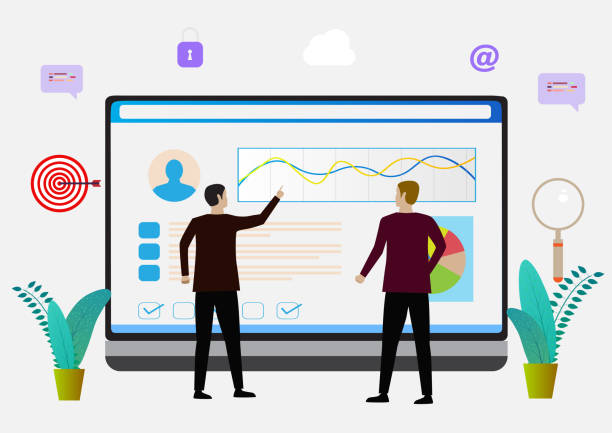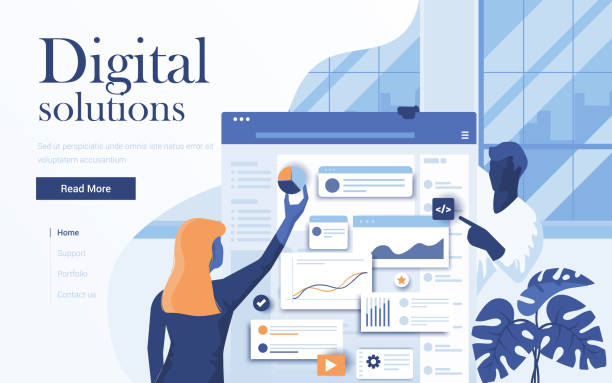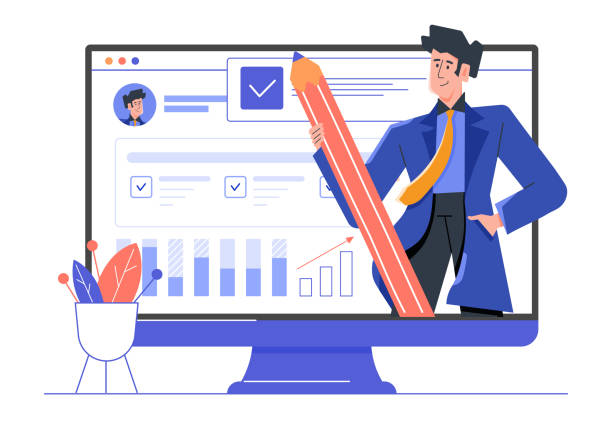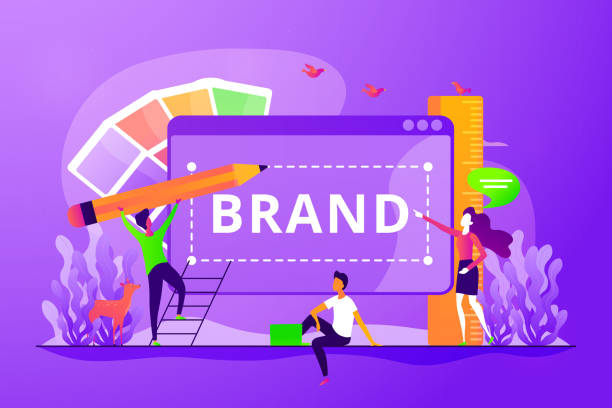The Importance of Fast Website Design in the Digital Age

In today’s fast-paced world, website loading speed is not just an advantage, but an undeniable necessity.
Users expect websites to load in a fraction of a second, otherwise, they quickly leave.
This phenomenon, known as #Bounce_Rate, can seriously impact your site’s search engine ranking and ultimately your business success.
The concept of fast website design has become increasingly important, as it is directly related to #User_Experience (UX) and #SEO.
Search engines like Google consider site speed as a key factor in page ranking.
Therefore, a slow website not only drives away potential customers but also reduces your chances of being seen in search results.
Fast website design means optimizing all technical and content aspects of a website to ensure it loads as quickly as possible.
This includes optimizing images, using caching, compressing code, and choosing suitable hosting.
The ultimate goal is for users to access the information they need without any interruption and to have an enjoyable experience on your website.
Did you know that even a one-second delay in loading can lead to a 7% reduction in Conversion? This is a thought-provoking piece of content that highlights the importance of the issue.
Are you tired of having visitors to your e-commerce site but no sales? RasaWeb solves your core problem with professional e-commerce website design!
✅ Significant increase in sales with targeted design
✅ Flawless user experience for your customers
⚡ Get a free consultation!
Fundamental Principles of Website Speed Optimization

To achieve fast website design, one must adhere to the fundamental principles of optimization.
These principles include several specialized and technical approaches, each playing a crucial role in reducing loading time.
One of the most important principles is Caching.
Caching means storing a copy of website content (such as images, CSS, and JavaScript files) in the user’s browser or on the server, so that on subsequent visits, there is no need to reload from the origin, significantly increasing access speed.
Another type of optimization is Image and Media Compression.
Large images are a primary cause of slow websites.
By using appropriate formats (like WebP), lossless compression, and making images responsive for different devices, their size can be drastically reduced.
Content Delivery Network (CDN) is also a powerful tool for increasing speed.
CDNs store your site’s content on various servers worldwide, so that each user receives content from the server closest to them, minimizing latency.
Furthermore, Minification and Combination of CSS and JavaScript files means removing whitespace, comments, and extra characters from codes and combining multiple small files into one larger file, which reduces the number of HTTP requests and helps with faster loading.
All these techniques combined significantly contribute to fast website design and a smoother user experience.
Proper training and implementation of these principles are critical steps in the path to speed optimization.
Choosing the Right Tools and Technologies for Speed

The correct selection of tools and technologies is the cornerstone of fast website design.
This guide will help you make the best decisions in this area.
One of the first choices is the Content Management System (CMS).
Popular CMSs like WordPress, Joomla, or Drupal offer many features, but each has its specific requirements for speed optimization.
WordPress, with its vast plugin ecosystem, provides many optimization capabilities, but choosing lightweight plugins and database optimization are crucial.
On the other hand, using web frameworks like React, Angular, or Vue.js can lead to the development of Single Page Applications (SPAs) that offer a very smooth and fast user experience, but require specialized programming knowledge.
Choosing a hosting company is also extremely important.
Shared hosting is cheaper but may not provide enough resources for a high-traffic website, while Virtual Private Servers (VPS) or Cloud Hosting offer better performance in terms of speed and stability, though at a higher cost.
A thorough evaluation of your website’s needs and budget is critical for choosing the best option.
This section explains different tools to help you decide on fast website design.
| Technology/Tool | Advantages for Speed | Key Optimization Tips |
|---|---|---|
| WordPress (CMS) | Ease of use, many plugins | Choose a lightweight theme, use caching and image optimization plugins, optimize database |
| React/Angular/Vue (Framework) | SPA (smooth UX), high client-side rendering speed | Code Splitting, Server-Side Rendering (SSR), package optimization |
| Cloud Hosting/VPS | Dedicated resources, high scalability, more control | Proper server configuration, use Nginx/LiteSpeed, enable Gzip |
| CDN (Content Delivery Network) | Reduced Latency, load distribution | Choose a suitable CDN with geographical coverage for your users, proper caching configuration |
The Role of User Experience (UX) in Speed and User Retention

Website speed is not just a technical metric; it directly impacts User Experience (UX) and ultimately determines user retention and conversion rates.
A website that loads quickly gives users a sense of satisfaction and efficiency.
Conversely, loading delays can lead to frustration, site abandonment (Bounce Rate), and ultimately, loss of customers.
This section analyzes this vital connection.
Research has shown that users wait only a few seconds for a page to load.
If the site doesn’t load within this time, many of them leave the page.
Therefore, fast website design means ensuring that the user has access to the desired content as soon as they arrive.
This includes optimizing initial visual elements (above-the-fold content) for instant loading so that the user feels the site is responsive, even if all content hasn’t loaded yet.
Smooth interactions, such as fast navigation between pages and instant form responses, are also part of this experience.
Search engines also consider site speed as a ranking factor due to the importance of user experience. The more satisfied users are with your website and the longer they spend on it, the more positive signals are sent to search engines, which helps improve SEO ranking.
In fact, fast website design is not just a technical optimization, but a strategic investment to improve the overall user experience and increase the effectiveness of your online business.
This is an analytical perspective that examines the importance of speed from the user’s point of view, not just technology.
Are you frustrated with the low conversion rate of visitors to customers on your e-commerce site?
RasaWeb transforms your e-commerce site into a powerful tool for attracting and converting customers!
✅ Significant increase in visitor-to-buyer conversion rate
✅ Exceptional user experience to increase customer satisfaction and loyalty
⚡ Get a free consultation from RasaWeb!
Mobile-First Approach and Responsive Design for Speed

In today’s world, where the majority of internet traffic comes from mobile devices, the Mobile-First Approach and Responsive Design are no longer options, but a necessity for fast website design.
Google has also adopted mobile-first indexing for years, meaning your site’s mobile version is the primary basis for ranking in search results.
This section addresses the educational and explanatory aspects of this approach.
Responsive design means that your website automatically adapts its layout and content to the user’s screen size (mobile, tablet, desktop). This is achieved through CSS Media Queries and a flexible design.
To achieve fast website design on mobile, specific points must be considered: Firstly, optimizing images for mobile is crucial; images should be delivered in appropriate sizes for smaller screens.
Secondly, reducing the size of CSS and JavaScript files that are essential for the desktop version but may be superfluous on mobile.
Thirdly, utilizing mobile browser capabilities such as Lazy Loading for images and videos, which loads content only when the user scrolls to it.
These techniques significantly improve initial loading speed.
Finally, continuous speed testing on various mobile devices and different networks (2G, 3G, 4G, 5G) is necessary to ensure optimal performance.
Focusing on mobile user experience and loading speed on this platform is key to ranking success and user retention in the current era.
Backend and Database Optimization for Maximum Speed

While frontend (user-side) optimization is crucial for fast website design, the vital role of the backend (server-side) and database cannot be overlooked.
This section delves into the specialized and explanatory aspects of server-side optimization.
An inefficient backend or a slow database can nullify all frontend efforts for speed. The first step is server code optimization.
Ensuring that your PHP, Python, Node.js, or any other programming language code is written efficiently and without unnecessary parts is very important.
Using optimized frameworks and efficient architectures can help in this regard.
The second step is database optimization.
Large and complex databases can cause severe slowdowns.
Using appropriate indexing for tables, optimizing queries, removing duplicate or unnecessary data, and periodic database cleanup are among the key actions.
Also, using database-level caching systems (like Redis or Memcached) can significantly reduce the response time for database requests.
The third step is server configuration optimization.
Using high-speed web servers like Nginx or LiteSpeed instead of Apache, enabling Gzip compression for transmitted content, and correctly setting up server-side caching can increase service speed.
These technical measures form the foundation of a fast and stable website design and ensure that your site can handle high traffic volumes with high performance.
Understanding and implementing these optimizations are essential for any developer seeking speed.
Continuously Measuring and Monitoring Website Speed

After implementing all optimizations for fast website design, the next step is continuous measurement and monitoring of site performance.
This is a crucial step to ensure speed stability and identify potential problems.
Several tools are available for this purpose, each providing different analytical data.
One of the most famous is Google PageSpeed Insights, which not only provides a score for your site’s speed on mobile and desktop but also offers specific recommendations for performance improvement.
GTmetrix is another tool that displays more detailed loading times, Waterfall charts, and YSlow and PageSpeed reports, which are useful for more specialized analyses.
Core Web Vitals are a set of metrics related to speed, responsiveness, and visual stability from Google that directly impact SEO.
Monitoring LCP (Largest Contentful Paint), FID (First Input Delay), and CLS (Cumulative Layout Shift) is crucial to ensure an optimal user experience.
These tools help you identify performance bottlenecks and resolve weaknesses.
Regular reports and automatic speed monitoring allow you to quickly react to any drop in speed and prevent a decrease in SEO ranking or user dissatisfaction.
This analytical and guiding process is an inseparable part of maintaining an optimized and stable fast website design.
| Tool Name | Key Metrics | Usage Tips |
|---|---|---|
| Google PageSpeed Insights | LCP, FID, CLS, Speed Score (mobile and desktop) | Provides detailed optimization recommendations, focuses on Core Web Vitals |
| GTmetrix | PageSpeed Score, YSlow Score, Fully Loaded Time, Total Page Size, Requests | More comprehensive analysis with Waterfall Chart, detailed reports |
| WebPageTest | First Byte Time, Start Render, Speed Index, Visual Complete | Ability to test from different geographical locations, simulate different internet speeds |
| Lighthouse (Chrome DevTools) | Performance, Accessibility, Best Practices, SEO | Built-in Chrome browser tool, quick and practical report |
Common Website Design Mistakes and Solutions to Avoid Them

In the process of fast website design, some common mistakes can nullify optimization efforts.
Identifying these mistakes and understanding solutions to avoid them is an important educational and guiding aspect.
The first mistake is excessive use of high-quality images without compression.
Although high-resolution images are attractive, their large size can significantly reduce loading speed.
The solution is to use optimized formats (like WebP), proper compression, and responsive features for images.
The second mistake is loading too many unnecessary JavaScript/CSS plugins or libraries.
Every extra plugin or script means more files to load and process.
The solution is to carefully review needs and remove unnecessary items, along with Minification and Combination of files.
The third mistake is lack of caching.
Ignoring server-side and client-side caching means that users load the entire site every time.
Enabling appropriate caching systems solves this problem.
The fourth mistake is choosing inappropriate and cheap hosting that does not have sufficient resources for your site.
Investing in quality hosting commensurate with anticipated traffic is essential.
The fifth mistake is lack of database optimization and slow queries, which can lead to server response delays.
Using optimized indexes and queries is the solution to this problem.
Finally, lack of continuous speed monitoring and ignoring optimization tool reports will make you unaware of potential issues.
By avoiding these common mistakes and focusing on correct solutions, you can achieve a fast and successful website design.
Are you dissatisfied with the low conversion rate of visitors to customers on your e-commerce site?
Solve this problem forever with professional e-commerce website design by RasaWeb!
✅ Increase visitor-to-customer conversion rate
✅ Create an excellent user experience and build customer trust
⚡ Get a free consultation
Future Trends in Web Performance and Speed

The web world is constantly evolving, and new trends in website performance and speed are emerging.
Awareness of these new and exciting developments is essential for anyone looking to maintain their position on the web.
One of the most important future trends is HTTP/3.
This new protocol, based on Google’s QUIC, is set to replace HTTP/2 and will bring significant improvements in web communication speed and security, especially on unstable and mobile networks.
With the widespread adoption of HTTP/3, fast website design will enter a new phase of optimization.
Another trend is the increased use of Artificial Intelligence (AI) and Machine Learning (ML) in performance optimization.
These technologies can analyze traffic patterns and user behavior and automatically apply optimizations such as intelligent caching, adaptive compression, and content preloading.
This can make the fast website design process more automatic and efficient.
Also, Progressive Web Apps (PWA), which offer a combination of the best features of web and native applications, are expanding.
PWAs provide capabilities such as offline work, push notifications, and faster access from the home screen, all of which lead to a smoother and faster user experience.
The last notable trend is the focus on Web Sustainability (Green Web Hosting).
While speed optimization means less resource and energy consumption, choosing hosting that uses renewable energy is also part of a forward-looking approach to web design.
These new trends show that fast website design goes beyond current techniques and is constantly evolving to provide the best possible user experience.
Conclusion and the Importance of Continuous Website Speed Optimization

In this article, we covered all aspects of fast website design; from its fundamental importance in the digital age and its impact on SEO and user experience, to specialized optimization principles, selecting appropriate tools, the vital role of backend and database, and methods of measurement and monitoring.
Finally, we touched upon common mistakes and future trends in this field.
In conclusion, it must be emphasized that website speed is not a one-time project; rather, it is a continuous and sustainable process.
Search engine algorithms are changing, new technologies are emerging, and user expectations are constantly increasing.
Therefore, to maintain a competitive advantage and provide the best possible user experience, continuous website speed optimization is essential. This section provides final explanation and guidance for users.
Investing in fast website design means investing in the future of your online business.
A fast website not only attracts more traffic and has higher conversion rates but also increases customer loyalty.
By using analytical tools, listening to user feedback, and keeping your technical knowledge up-to-date, you can ensure that your website always remains at its peak performance.
Remember that in today’s competitive world, a fast website is the key to sustainable success. This is the message that all previous sections lead to, emphasizing the importance of continuous optimization.
Frequently Asked Questions
| Question | Answer |
|---|---|
| What is fast website design? | The process of building a website that loads quickly and provides a smooth user experience. |
| Why is website speed important? | Improved user experience, reduced bounce rate, increased conversion rate, and better search engine ranking (SEO). |
| What factors affect website speed? | Image size, number of HTTP requests, code optimization (HTML, CSS, JS), host speed, and browser cache. |
| How can website speed be improved? | Optimizing images, compressing files, using caching, choosing suitable hosting, and reducing unnecessary plugins. |
| How do images affect website speed? | High-volume or improperly formatted images can significantly increase page load time. |
| What is the role of JavaScript and CSS in website speed? | Unoptimized, large, or render-blocking code can reduce page rendering speed. |
| How much does hosting affect website speed? | The speed and quality of the hosting server directly impact the website’s response time and initial loading speed. |
| What tools are available to check website speed? | Google PageSpeed Insights, GTmetrix, Pingdom Tools are common tools. |
| What are the benefits of a fast website? | Greater user satisfaction, reduced bounce rate, increased time spent on site, and improved ranking in Google results (SEO). |
| What are common mistakes that slow down a website? | Using unoptimized images, bulky and unorganized coding, excessive use of plugins, and not using caching. |
And other services of RasaWeb Advertising Agency in the field of advertising
Smart Link Building: A professional solution for digital branding with a focus on precise audience targeting.
Smart Marketing Automation: A creative platform for improving campaign management with marketing automation.
Smart Data Analysis: Designed for businesses seeking to improve SEO ranking through marketing automation.
Smart Direct Marketing: Professional optimization for increasing sales using custom programming.
Smart Social Media: A dedicated service for increasing sales growth based on precise audience targeting.
And over a hundred other services in the field of internet advertising, advertising consultation, and organizational solutions
Internet Advertising | Advertising Strategy | Advertorials
Sources
Website Design at Iran HostWebsite Design Tips for Virtual ServersSEO and Website Design Articles at Parsian HostWebsite Optimization at Raya System
? Are you ready to transform your business in the digital space? Rasaweb Afarin Digital Marketing Agency provides innovative and comprehensive solutions including professional SEO, strategic social media management, and responsive website design, paving your way to success.
📍 Tehran, Mirdamad Street, next to Central Bank, Kazeroun Jonoubi Alley, Ramin Alley, No. 6

